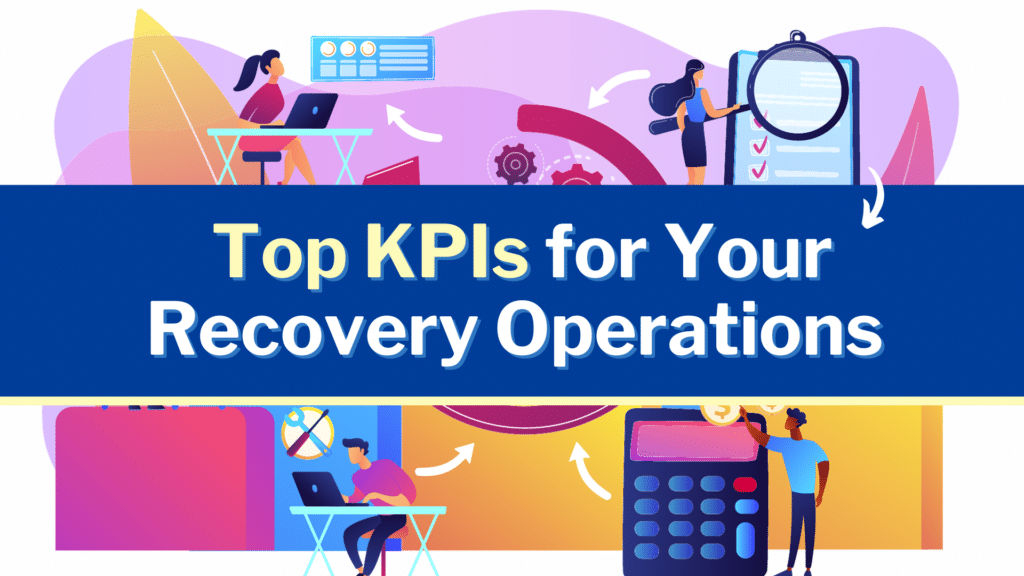The goal of a recovery operation is to maximize profitability by efficiently recovering money lent to consumers—while maintaining consumer loyalty. This means that measuring the success of a recovery strategy goes beyond just dollars and cents and into consumer-centric metrics as well.
But how do teams measure overall portfolio performance, and what are the most important portfolio-level key performance metrics (KPIs)? Let’s take a look at a few of the top KPIs and how they can be categorized.
Key Collections Metrics
Key performance indicators for debt collection and recovery efforts:
- Accounts per Employee (APE) or Accounts to Creditor Ratio (ACR): the number of delinquent accounts that can be serviced by an individual recovery agent
- Net Loss Rate or Net Charge Off Rate: measures the total percent of dollars loaned that ended up getting written off as a loss
- Delinquency Rate: total dollars that are in delinquency (starting as soon as a borrower misses a payment on a loan) as a percentage of total outstanding loans – often an early warning sign on the total volume of delinquent debt
- Promise to Pay Rate: the percentage of delinquent accounts that make a verbal or digital commitment to pay
- Promise to Pay Kept Rate: the percentage of delinquent accounts that maintain a stated commitment to pay
- Roll Rate: the percentage of delinquent dollars that “roll” from one delinquency bucket to the next over a given period of time – provides visibility into the velocity with which debts are heading into charge off
Metrics like net loss rate are the north star of a recovery program, while metrics like delinquency rate and roll rate are leading indicators of future portfolio performance. But just as critical as these traditional KPIs, today’s collection operations need to focus on implementing and measuring digital engagement.
Digital Engagement Metrics
A range of KPIs that capture how effectively digital channels are reaching and engaging consumers:
- Coverage: the percentage of users for whom we have digital contact information
- Deliverability: the percentage of digital messages that are actually reaching consumers
- Digital Opt-In: the percentage of users who have consented to receive digital communications in a particular channel
- Open Rate, Clickthrough Rate: the percentage of users who are actually opening and clicking digital communications
Following key collection and digital engagement metrics are all well and good, but how do recovery teams move the needle on those critical KPIs?
Operational metrics are the KPIs that collectively drive overall portfolio-level performance. They represent the “levers” available to change the economics of a recovery model.
Operational Metrics
Metrics that create simple framework to explain the profitability of a recovery operation:
- Profitability of a Collections Operation Formula: R x ResF x E
- R [Reach]: percentage of consumers in delinquency can you actually reach
- ResF [Resolution Funnel]: how effectively you can convert initial contact with a consumer into a commitment to pay – and ultimately, a payment promise kept (see Promise to Pay Rate and Promise to Pay Kept Rate)
- E [Efficiency]: calculation of what the “unit economics” of your collection are and how much it costs, on average, for every account that you rehabilitate
In the hyper-competitive financial services space, consumer experience is a source of competitive advantage. That’s why it stands to reason that alongside the “traditional” metrics of recovery economics, forward-looking businesses have pioneered a new set of KPIs that measure the value of consumer experience.
Consumer-Centric Metrics
A new set of KPIs that measure the value of consumer experience:
- Net Promoter Score (NPS): how likely a consumer is to recommend a given brand after an experience with a brand’s collection organization
- Customer Retention Rate: how likely a consumer is to be reacquired by a given brand after his or her delinquent account is rehabilitated
Keep a Close Watch on These KPIs for Collection
As payment-driven organizations across verticals focus further into the world of recovery, it is safe to anticipate that digital engagement and consumer-centric KPIs like the ones we covered above will become even more deeply woven into the fabric of the organization.
Ready to evaluate your debt recovery operations using more sophisticated KPIs? Schedule a consultation to get started today»»
